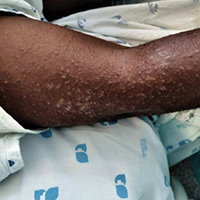DRESS syndrome (drug rash with eosinophilia and systemic symptoms): sometimes, not all signs are there

All claims expressed in this article are solely those of the authors and do not necessarily represent those of their affiliated organizations, or those of the publisher, the editors and the reviewers. Any product that may be evaluated in this article or claim that may be made by its manufacturer is not guaranteed or endorsed by the publisher.
Authors
DRESS syndrome is a rare and potentially fatal multisystemic reaction that occurs two to six weeks after exposure to certain drugs. It is characterized by fever, eosinophilia, and skin rash. Case of a 37-year-old man, black, with gout (started allopurinol 4 weeks before). He arrived at the Emergency Room complaining of headache, fever, abdominal pain, and scattered maculopapular skin lesions. The conducted study showed elevated transaminases and C-reactive protein, hepatomegaly, and peri-hepatic adenomegalies. Allopurinol was stopped, but throughout hospitalization, liver, renal and neurological dysfunctions (with meningoencephalitis) worsened; it also appeared eosinophilia. A skin biopsy was performed, the possibility of DRESS syndrome was assumed, and methylprednisolone 2 mg/kg/day was started, with progressive improvement. The skin biopsy was compatible with DRESS. The described case reveals some peculiarities. Among the most relevant arethe late onset of eosinophilia and the difficulty in evaluating the rash due to the patient's skin tone and neurological manifestations (rare).
How to Cite

This work is licensed under a Creative Commons Attribution-NonCommercial 4.0 International License.
PAGEPress has chosen to apply the Creative Commons Attribution NonCommercial 4.0 International License (CC BY-NC 4.0) to all manuscripts to be published.








